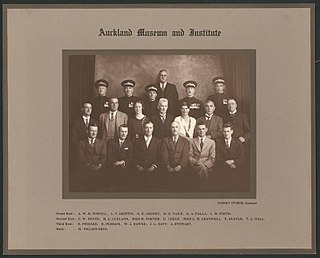
Arthur William Baden Powell was a New Zealand malacologist, naturalist and palaeontologist, a major influence in the study and classification of New Zealand molluscs through much of the 20th century. He was known to his friends and family by his third name, "Baden".

The Berothidae are a family of winged insects of the order Neuroptera. They are known commonly as the beaded lacewings. The family was first named by Anton Handlirsch in 1906. The family consists of 24 genera and 110 living species distributed discontinuously worldwide, mostly in tropical and subtropical regions. Numerous extinct species have also been described. Their ecology is poorly known, but in the species where larval stages have been documented, the larvae are predators of termites.

Chrysopa is a genus of green lacewings in the neuropteran family Chrysopidae.
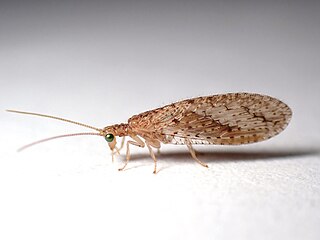
Micromus tasmaniae, known as the Tasmanian brown lacewing, is a species of brown lacewing in the family Hemerobiidae. It is widespread in Australia, New Zealand, and Pacific Islands such as New Caledonia and Vanuatu.
Sympherobius californicus is a species of brown lacewing in the family Hemerobiidae. It is found in Central America, North America, and Oceania. The species was introduced to New Zealand to prey on aphids and mealybugs affecting crops, first noted in 1936, however was not able to be established.
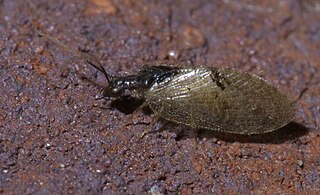
Sympherobius barberi, or Barber's brown lacewing, is a species of brown lacewing in the family Hemerobiidae. It is found in Europe and Northern Asia, Central America, North America, Oceania, and South America. The species was introduced to New Zealand to prey on aphids and mealybugs, first noted in 1936, however was not able to be established.
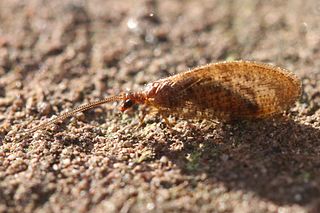
Hemerobius stigma is a species of brown lacewing in the family Hemerobiidae. It is found in Europe and Northern Asia and North America. The species was introduced to New Zealand to prey on adelgidae growing on pine plantations, and was first noted as being present in the country in 1935, however was not able to be established.

Chrysopa oculata is a species of green lacewing in the family Chrysopidae. It is found in North America and Central America. This species was imported to New Zealand in 1926, as a way to control aphid populations, however did not establish in the country.

Mallada basalis is a species of green lacewing in the family Chrysopidae, first described by Francis Walker in 1853. No subspecies are listed in the Catalog of Life. The species was detected on mainland New Zealand in the 2010s.
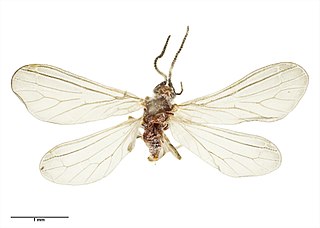
Cryptoscenea australiensis is a species of lacewing in the subfamily aleuropteryginae, first described by Günther Enderlein in 1906. No subspecies are listed in the Catalog of Life. The species is present in Eastern Australia, Tasmania and New Zealand, including the Kermadec Islands.

Drepanacra binocula, known as the Australian variable lacewing, is a species of brown lacewing in the family Hemerobiidae, found across Australia and New Zealand, including Lord Howe Island, Norfolk Island and the Kermadec Islands.

Micromus bifasciatus, is a species of Australasian brown lacewing in the family Hemerobiidae that was first described by Robert John Tillyard in 1923.
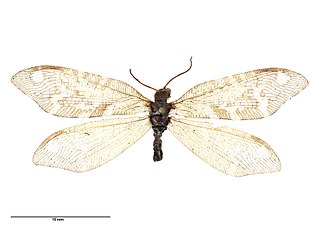
Euosmylus stellae is an endemic species of New Zealand lacewing that was first described by Robert McLachlan in 1899. It is the only species in the genus Euosmylus. The species ranges from the North Island Volcanic Plateau to the middle of the South Island, including Arthur's Pass and the Ashley Gorge. It was named in honour of George Hudson's daughter Stella.

Heteroconis ornata is a species of Australian lacewing that was first described by Günther Enderlein in 1905. The species is found in Queensland and New South Wales. The species was first recorded in New Zealand in 1988, and by the late 1980s a small colony was found to be established in West Auckland.
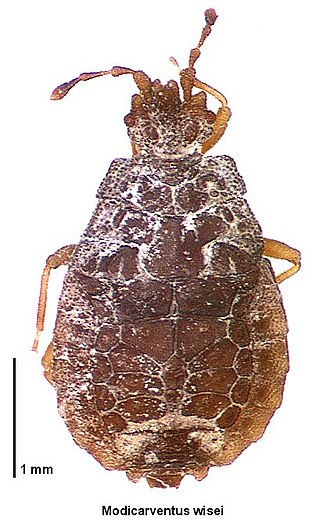
Modicarventus wisei is an endemic species of New Zealand flat bug, described by Kirman in 1989. The specimens were first collected from Unuwhao on the North Cape in February 1967 by K.A.J. Wise, but not described as a new species until 1989. It is in the subfamily Carventinae.
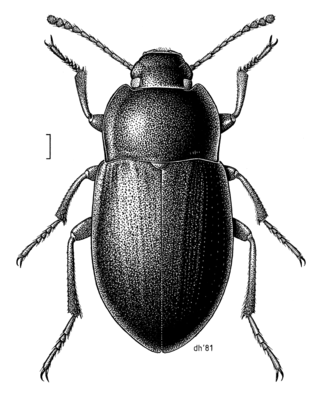
Mimopeus elongatus is a species of darkling beetle in the subfamily Tenebrioninae, first described by Ferdinando Arborio Gattinara di Breme in 1842, who considered it a type of Cilibe.

Gyrinus convexiusculus is a species of whirligig beetle in the family Gyrinidae, first described by Macleay in 1871.

Keith Arthur John Wise, often referred to as K. A. J. Wise, was a New Zealand entomologist. Originally employed at the Department of Scientific and Industrial Research, Wise began working with the Bishop Museum in the early 1960s, coordinating field programmes for United States visits to Antarctica and Subantarctic islands. This work led Wise to identify and describe large numbers of novel species, including many species of springtail. In 1965, Wise became the first Curator of Entomology at the Auckland War Memorial Museum, where he was integral in creating the first entomology section within the natural history gallery.

Pycnocentrodes is a genus of caddisflies belonging to the family Conoesucidae. The genus was first recognised by Robert John Tillyard in 1924. All known species of Pycnocentrodes are endemic to New Zealand.
Confluens is a genus of caddisflies belonging to the family Oeconesidae. The genus was described by Keith Arthur John Wise in 1962, after noticing differences in two species previously placed within the genus Pycnocentrodes. Both species of Confluens are endemic to New Zealand.


















